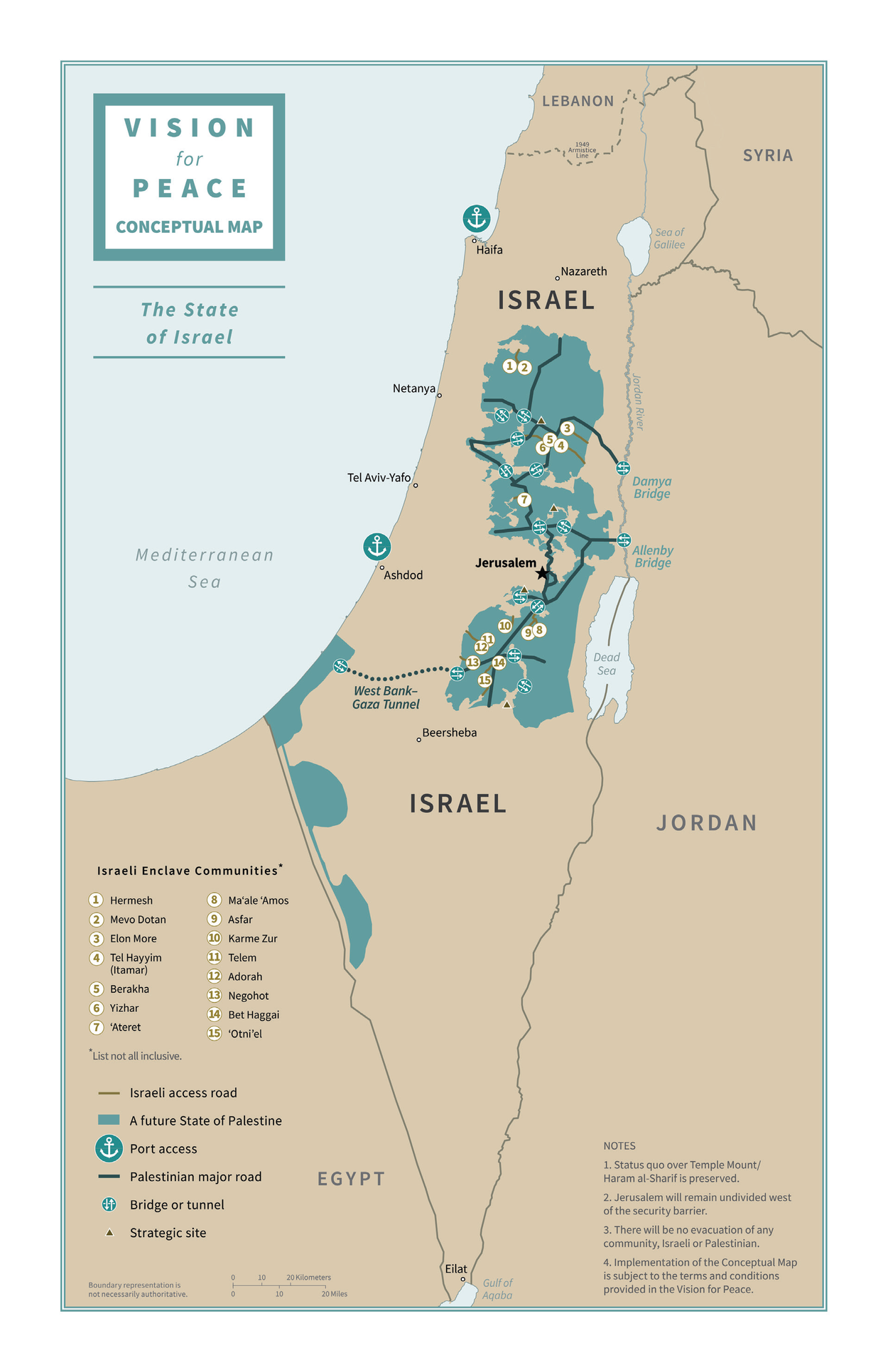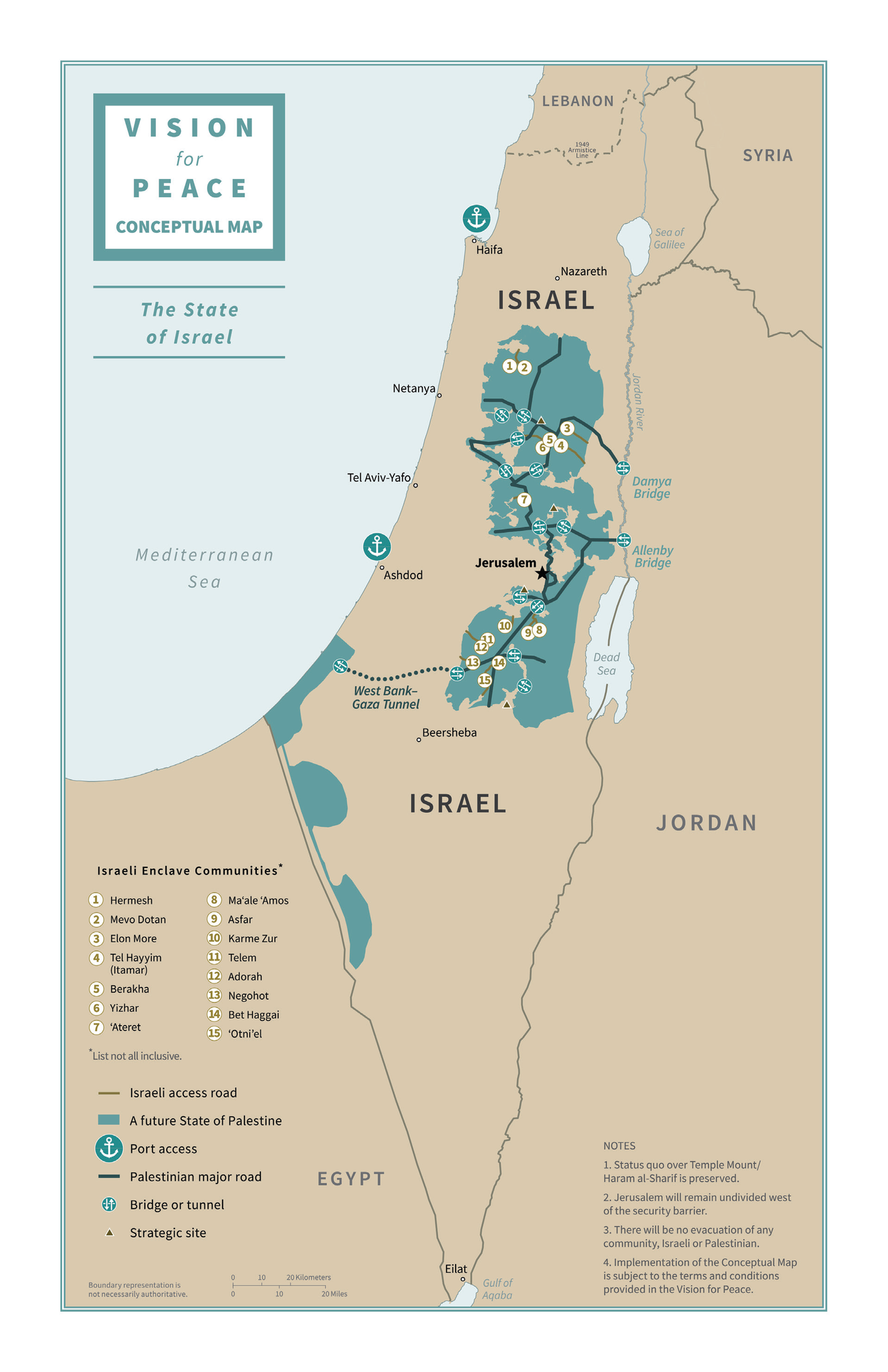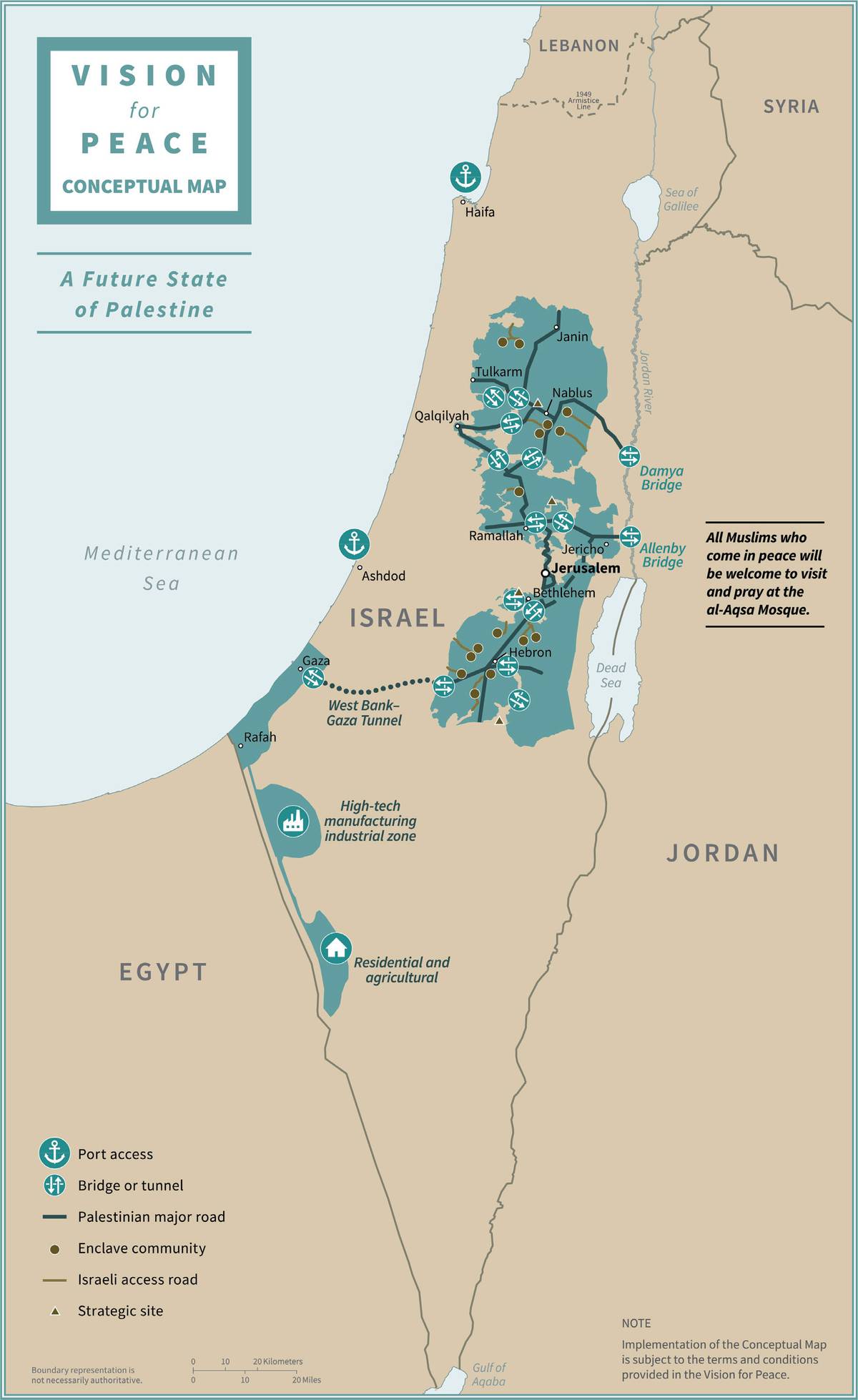The Demographic Realities of Annexation
Slow but ceaseless movement strategically transforms the human landscape




More than 40 years ago, during a sabbatical in Rhode Island, I purchased a used car. The seller wrote on a piece of paper: “As is, where is,” and the price. He said: “Note the little dent on the left back door.” I paid cash, entered the car, took the wheel, and left.
“Peace to Prosperity,” the 180-page paper circulated by the White House last January, outlines a similar scenario: Two sides, a written transaction framework—just a little more elaborate—with the addition of an honest broker who asks nothing for himself. But in this case one side, Israel—represented by Benjamin Netanyahu—says: I’ll take the car and drive away. No mentioning of the price or intention to pay. The other side, the Palestinians, does not even bother to be present.
And so, not unexpectedly, the date announced for this momentous transaction, July 1, passed while the primary actors were otherwise busy: The Israelis with the second wave of COVID-19 and the ensuing dramatic economic recession; the Palestinians with self-inflicted scourging; and Trump with a stumbling presidential campaign.
At the same time, just by raising the possibility of a unilateral annexation of the Jordan Valley and the circumscribed municipal territory of the 127 Israeli settlements in the West Bank, Israel has sparked a spirited debate about the concrete terms and likely consequences of changing the map. A review of the demographic realities prevailing in the territories in question can help to illuminate the likely effects of the possibilities raised by the Trump plan and by politicians inside and outside Israel who support or oppose it.
What and where is the Jordan Valley? Biq’at Hayarden (in Hebrew) has been referred to as Israel’s eastern security border, though many defense experts believe that under contemporary war concepts (unlike in the 1960s), Israel’s actual security border transits between Iraq and Iran—provided Israeli troops continue patrolling along the river. Shortly after the Six-Day War in 1967, the Jordan Valley was included in the Allon Plan—which remains the most detailed and internally coherent Israeli attempt to envisage a postwar redrawing of the Middle Eastern map; the plan was later endorsed by Yitzhak Rabin in 1995. The Allon and Trump maps are very similar, although it is not clear which territory exactly would now be up for annexation—whether only a narrow flat band between the Beit She’an Valley south of the Sea of Galilee and the Dead Sea’s northern shore, or also the western slope up and beyond the edge of the West Bank plateau (as in Allon’s plan). The possible annexation of the Jordan Valley by Israel that is specified in “Peace to Prosperity” also suggests that Israel should cede to the Palestinians an approximately equivalent amount of territory next to its border with Egypt.

The Israeli administration has divided the valley’s settled areas into two regional councils encompassing a total of 6,900 people: Bik’at HaYarden with 5,200 Jewish inhabitants, and Megilot, which expands southward along the western coast of the Dead Sea, with 1,700. (Here and in the following, Jewish includes non-Jewish members of Jewish households admitted under the Law of Return.) The Jewish population is further subdivided into 26 small rural localities. These numbers do not include the 20,900 Palestinians living in the city of Jericho, at the valley’s southern edge, and several more thousands scattered in villages farther north. While Jericho is not a candidate for annexation, the incorporation of the villages would significantly alter the demographic composition of the—admittedly very small—population that might be annexed to the Israeli state. The fact remains that for over 50 years, the now rediscovered Jordan Valley has remained quite at the margins of the Israeli project.
The demographic/territorial equation is far more complex when looking at the other territory targeted by a majority of (but not all) Israel’s government for immediate annexation, namely the municipal boundaries of the settlements built since 1968 beyond the pre-Six-Day War Green Line (the 1949 armistice line). Complications begin from the very naming of the region, underlying the different narratives of the parties involved. West Bank is the more neutral as it refers to the morphology of a river, the Jordan. In Jewish practice the same area is called Judea (south of Jerusalem) and Samaria (to the north). A more precise biblical tribal labeling of the latter would be Binyamin, Ephraim, and part of Manasseh. And all of this without mentioning the outskirts of Jerusalem, which were annexed by Israel in July 1967.
The demographic transformation of the West Bank area since the 1967 war has been quite extraordinary. In November 1967, Israel carried out a census of the West Bank (and also of Gaza) and found a Palestinian population of 586,000 (plus 69,000 in East Jerusalem). This was after some 150,000 Palestinians had fled to the east bank of the river in June 1967. At the end of 2019, the total of West Bank Palestinians had grown to 2,642,000—4.5 times larger than 52 years earlier, plus 358,000 in East Jerusalem—5.2 times larger.
The post-1967 Jewish population of the area, which started from a few individuals in 1968, passed the 10,000 mark in 1977. It has since grown rapidly to 175,000 in 1997, and to 443,000 in 2019, plus 230,000 in the Jerusalem areas incorporated in 1967. The total West Bank population excluding Jerusalem thus reached 3,085,000 in 2019, of which Jews constituted 14%.
Israeli localities of the West Bank are quite heterogeneous. According to the latest detailed data for end 2018, 427,800 Israelis lived in the West Bank, not including Jerusalem’s neighborhoods, in 15 towns with a population of 5,000 and over, for a total of 279,000. The largest were Modi’in Illit (73,100) and Beitar Illit (56,700)—both Haredi cities. In the March 2020 elections, the Likud party won all non-Haredi towns—including Ma’ale Adumim (38,200), Ariel (20,500), Giv’at Ze’ev (17,900), Oranit (8,800), Alfei Menashe (7,900), and Kiryat Arba (7,300)—with the exception of Efrat (10,100), Karnei Shomron (7,700), and Beit El (6,000), where the national religious party Yamina prevailed. Another 26 urban localities with 2,000-5,000 inhabitants each, including Immanuel and Ma’ale Ephraim, totaled 80,500 Israeli inhabitants. Finally, 86 rural localities of fewer than 2,000 inhabitants totaling 68,300, comprised 51 communal localities, 23 moshavim, nine kibbutzim, and three other rural locals.
Demography can be relegated to the role of a necessary but dull background factor hidden behind more glamorous and thought-provoking projects, directives, and decisions whose power is to reshape the destiny of mankind. Yet, with its slow-motion and ceaseless movement forward, demography strategically transforms the human landscape, while remaining deaf to the rhetoric of politicians.
If ideology was the main factor driving the settling of Judea and Samaria, Jewish population growth was also strongly incentivized by lower housing costs and other subsidies. Today, the main engine of Jewish demographic growth in the area captured from Jordan in the 1967 war is the high natural increase of a young and traditional population.
Netanyahu’s relatively limited annexation goals are viewed as too little, too late by those who, in the spirit of the Eretz Israel Hashlema movement, would like to annex all of Judea and Samaria. Israel national poet and leading intellectual Nathan Alterman was the first who identified the central theme that would animate political cleavage for the next half-century. In an article published on June 16, 1967, in Ma’ariv, he wrote: “The interest of victory rests in that it practically deleted the difference between the State of Israel and the Land of Israel. For the first time since the destruction of the Second Temple, Eretz Israel is in our hands. From now, State and Land are one.”
Alterman’s identification of the borders of the Jewish state with the biblical Land of Israel was far from the political consensus at the time, as shown by the recently released protocols of the national union government led by Levi Eshkol, one of whose members was Menachem Begin. Those protocols clearly indicate that in the days immediately following the Six-Day War, Israel had no plan for annexation of the territories that had just fallen under Israeli control. Among the reasons mentioned was the demographic challenge that such annexation would pose to Israel as a Jewish state.
At the end of 2019, Israel’s Jewish population of 7.2 million (including the over 400,000 non-Jewish relatives) constituted 79% of the country’s total—including East Jerusalem, the West Bank’s Jewish population, and the Golan Heights. That was a reasonable majority for a sovereign polity claiming to be the Jewish state. But when factoring in the 2.6 million West Bank Palestinians (without Jerusalem), the emerging conglomerate population of Israel including the entire West Bank would amount to 11.8 million, of which 61% would be Jewish. Such a state would still possess a substantial Jewish majority, but not one necessarily large enough to guarantee a peaceful consensus around the scope, thrust, and symbols of the country.
There are, in fact, no successful examples of livable societies with similarly heterogeneous compositions—not the former Yugoslavia in Europe, nor Guyana in South America, Ireland in the British Isles, South Sudan in Central Africa, or for that matter, Belgium.
The recurring suggestion of one state for two people, Israelis and Palestinians, is therefore no more than annoying background noise. Its probability matches the scenario of one state for two people involving the fusion of the United States and Mexico, or maybe France and Germany.
What we are left with is the principle that there are no shortcuts in serious policy transactions. “Peace to Prosperity” dutifully considers population among other variables and can provide effective advice if political leaders capture the demography of the region as is, where is.
Sergio DellaPergola is Professor Emeritus of demography at the A. Harman Institute of Contemporary Jewry, The Hebrew University of Jerusalem.